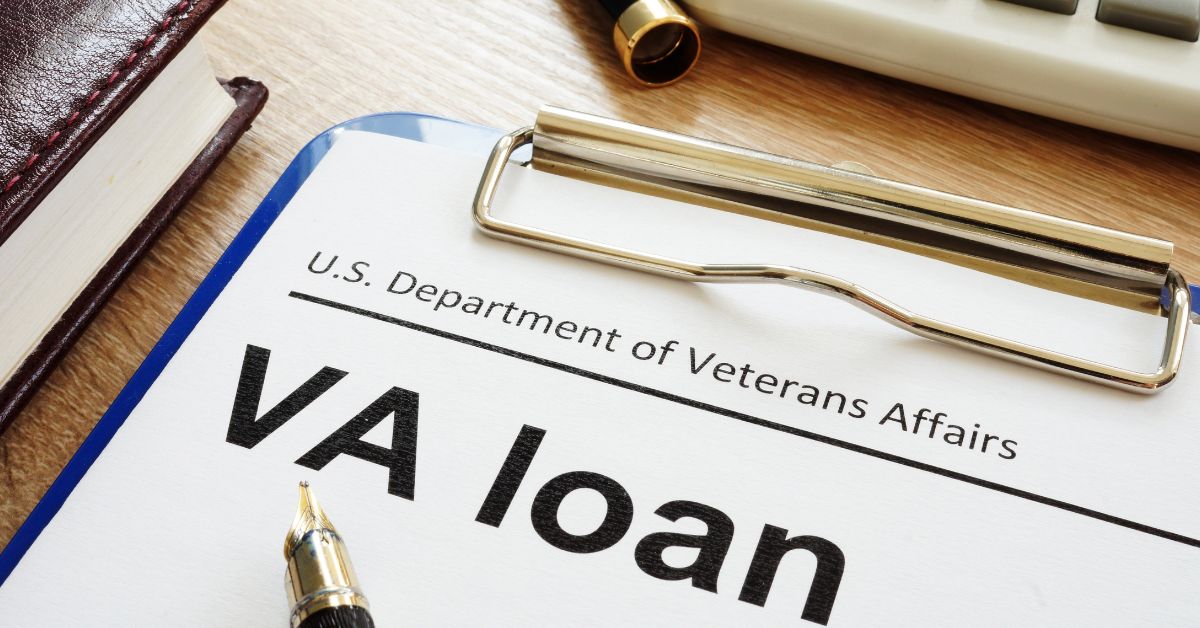Ever cruised down the open road, spotted a “For Sale” sign on a lovely piece of land, and thought, “That’d be just perfect for my new home?”
Then, before you let your heart race with excitement, does an important question pop up: “Will my VA home loan cover this? Is there a limit on how much land I can buy?”
If this sounds like you, buckle in. We are hitting the highway of home financing and exploring the terrain of VA home loans and their acreage limits. Are you ready? Let’s roll!
Understanding VA Home Loan Acreage Limit
When it comes to VA home loans, there’s a quirky little question that pops up more than you’d imagine: Is there a VA home loan acreage limit? You’d think it’d be a simple YES or NO answer, wouldn’t you?
But just like cooking a 5-star meal or finding the perfect pair of jeans, it’s a touch more complex than that.
So let’s roll up those sleeves and delve right in to understand how this acreage limit impacts veterans looking to unpack their dreams in a cozy home.
What Exactly is the VA Home Loan Acreage Limit?
In simple terms, the VA does not have a strict acreage limit. That’s right, put on your party hat because there’s no hard cap! However, this doesn’t mean you can start your own private Idaho.
Here’s why: the VA will guarantee any home that’s ‘reasonable’ for residential purposes. Now, if ‘reasonable’ sounds as vague as a foggy winter morning, it’s because it basically depends on two major things:
- Comparable in the Neighborhood: Simply put, your dream house (and its land) should be in the same ballpark as other homes in the region.
- The Property’s Residential Utility: Here, the property should primarily serve as a residential dwelling and not an income-producing agricultural property.
Making Sense of the Limit
You might be wondering, Why this emphasis on ‘reasonable’? Let’s think of it this way: it’s like the Three Bears principle. You remember the tale, right? Goldilocks trying out chairs, porridge, and beds? Just like her, your property can’t be ‘too big’ or ‘too small’ – it has to be ‘just right’.
So, the VA focuses on guaranteeing home loans for veterans to live in, not trying to accommodate every agricultural pursuit under the sun. Here are a couple of reasons behind this principle:
- Future Resale: Residential properties are easier to sell compared to agricultural ones, providing safeguards for the marketability of the property in case of foreclosure.
- Typical Living Standards: The VA aims at ensuring that veterans can live comfortably and pleasantly, as per normal residential standards.
There you have it! Understanding the VA home loan acreage limit is like solving an interesting puzzle – once you get the hang of it, it’s not as daunting as it might initially seem. Armed with this knowledge, you’re one step closer to navigating your home financing journey like a pro!
Difference Between a Home and Land Loan

Remember the spontaneous road trip we spoke of? Well, you pull over in front of the For Sale sign, eyeing this lovely patch of wide-open land like a hungry fox. Now the spark in your question moves towards buying acres of land with a VA loan. But hold up just a second!
There’s a tiny twist here: There’s a difference between a home loan and a land loan. Yes, it’s like choosing between apple pie and apple crumble. Both sound similar but have different textures, flavors, and ingredients – or in our case, benefits and drawbacks.
Here’s a quick table to help you spot the differences:
| Loan Type | Purpose | Interest Rate | Down Payment Requirement | Other Key Features |
|---|---|---|---|---|
| VA Home Loan | To buy, build, or improve a home. | Varies, often lower. | None required. | No PMI, funding fee can be rolled into the loan. |
| VA Land Loan | To buy land for a future home site. | Varies, due to higher risk. | None required. | The VA guarantee may help secure better terms. |
Buy Land with a VA Loan: Process and Guidelines
Drawing from my years of steering Veteran Affairs benefits, buying land with a VA loan can be as thrilling as an action-packed blockbuster movie! It’s an exciting venture, but before you dive in, wouldn’t it be great to have a preview of the plot?
Here’s a step-by-step guide to help you unveil the story of securing a VA loan.
To Buy or Build?
Let’s start by figuring out your end game. Are you planning to turn that lovely patch of land into a beautiful home immediately? Or are you buying now to build at some future date? Your plans determine how smoothly your VA loan story will unfold.
What if you just want to spruce things up a bit, maybe a new kitchen or an energy-efficient upgrade? Well, you’re in luck! Because you can use a VA loan for VA Home Improvements.
Home Loan or Land Loan?
From our VA home loan cineplex, you’ve got two movie options:
- If you’re planning to build right away, it’s all about the VA construction loan.
- For those dreaming of a future build, say hello to the VA land loan.
Thinking about the freedom of a mobile home? Well, guess what? Your benefits stretch to that dream too. With a VA Loan for Mobile Homes, you can finance that house-on-wheels you’ve been eyeing.
Checklist for a Land Loan
Just like any good movie, you need to know the key highlights to follow the story. Grab your notebook, because we’re drafting a checklist for your loan:
- Eligibility: Brush off that glorious record of service, because it’s your ticket to this show.
- Loan Application: Ready to commit to the plot? It’s time to fill in your loan application form.
- Credit and Income Review: A slight plot twist, it’s important to confirm you’ve got the financial capabilities to repay your loan.
- Land Appraisal: This star scene involves assessing the plot’s market value.
Key Guidelines
While braving your loan adventure, keep an eye on the following guidelines to ensure your journey goes as smoothly as a catchy movie soundtrack:
- Aim to build: The land must be pegged for residential property construction. It’s not the movie for agricultural or commercial projects.
- Commit to a timeline: If you’re not building soon after buying, have a clear timeline ready. The VA doesn’t want those movie credits rolling with no end in sight.
VA Loan Approval
When all the paperwork is in order and you’ve met the prerequisites, you’re nearing the end of this blockbusting movie. Ready, set, and once you receive your loan approval… ‘Action’! With this all-purpose guide with you, rest assured you’ll be ready when the curtain raises on buying land with a VA loan!
Exploring the VA Land Loan

Much like the hidden details in a beautiful painting, there are features, benefits, and restrictions of land loans that you should know about. Trust me, it isn’t rocket science, and I promise you, having this knowledge in your back pocket might feel as comfortable as your favorite old shoes!
Pretend for a moment we’re at a grand buffet of loan options, and on your plate, you have a VA land loan, a traditional land loan, and an FHA land loan. Want to know how they each add flavor to your financial feast?
Well, let’s savor the details in the next comparison chart:
| Loan Type | VA Land Loan | Traditional Land Loan | FHA Land Loan |
|---|---|---|---|
| Interest Rate | Varies, due to higher risk. | Typically higher due to the land being a riskier investment. | Varies based on lender and borrower credit. |
| Down Payment | None required. | Typically 20-50%. | At least 3.5% |
| Loan Term | Typically 15-30 years. | Shorter, often 10-15 years. | Varies according to lender policies. |
| Eligibility | Military service members, veterans, and their spouses. | Not restricted. | Not restricted. |
Right before embarking on your property ownership journey, it’s wise to consider a VA home loan prequalification. This can be a quick way to ascertain whether you meet certain basic criteria even before you dive into full-fledged loan paperwork. It’s like scouting the waters before the actual swim.
Getting VA Loan Approved
When it comes to getting your VA loan approved, there are a few prerequisites, think of them as items on your grocery list. An essential item in this list is an appraisal. Understanding its role and significance in the VA loan approval process is as important as getting your morning coffee right.
Here’s a list highlighting the requirements for a VA loan approval:
- Certificate of Eligibility (COE): Proves eligibility for a VA-backed loan.
- Sufficient Credit Score: Typically requires a credit score of 600 or higher, although requirements may vary by lender.
- Adequate Income: Demonstrates stable and reliable income that can cover expenses.
- Property Appraisal: VA-approved appraiser assesses the property’s value and ensures it meets the VA’s minimum requirements.
Remember, as you navigate through your home or land purchase with a VA Loan, you must also meet the VA Loan Occupancy Requirements.
This essentially means that you, the veteran, are required to occupy the home as your primary residence. Think of it like this, the home you buy with your VA loan should not just be a house, but a lived-in, warmed-up home.
Tips for Working with a Lender for VA Loan Approval

Alright, finding your perfect lender is kind of like matchmaking – you want to find someone whose goals align with yours, and who understands your needs. Sounds pretty serious, right?
Looking back at countless interactions with lenders, I’ve got a set of handy tips, or consider them Cupid’s arrows if you will, to guide you on this match-making spree.
Picking the Right Lender
First things first, we need to find you a lender who’s VA-loan savvy. Here’s what you should consider while choosing your lender:
- Experience with VA Loans: You want someone who knows the ins and outs of VA loans like the back of their hand. An experienced lender understands the VA loan process, and requirements and can guide you seamlessly.
- Competitive Interest Rates: A good lender offers competitive interest rates on VA loans, so dig deeper into what they offer.
- Good Customer Service: Consider how the lender treats you during the initial interactions. Are they patient with your questions? Do they communicate clearly? This could be reflective of your future dealings.
Smoothing the Approval Process
In the colorful parade of mortgage lenders, you’ve found your match. Now, how do you charm your way to loan approval? Think of these pointers as the little whispers in your lender’s ear:
- Complete Documents: It’s like making a pie, you need all the ingredients. Assemble all required documents before submitting your application to avoid delays.
- Honesty Pays: Be upfront about your financial situation. This transparency helps your lender advise you properly and avoid bumps down the road.
- Prompt Responses: Time is of the essence, my friends! Be prompt in responding to your lender’s inquiries or requests for additional information.
Remember, romance isn’t built in a day, and neither is a good relationship with your lender. Keep these tips in your pocket, and I’m confident that you’ll secure your loan approval with poise and ease.
Making the Most of Your VA Benefits
Embarking on the quest for property ownership might seem like climbing a mountain. Fortunately, with VA benefits and loans as your climbing gear, the journey becomes more navigable. Whether your dream lies in a snug cottage or extensive land, a solid understanding of these VA loans equips you with the necessary tools to ascend confidently.
With your sights set on the peak, the path to ownership could still be riddled with challenges. But remember, you have in your possession a powerful map – your VA benefits. They’re not just benefits; think of them as milestones that make the journey achievable and the dream closer to reality.
Frequently Asked Questions on VA Home Loan Acreage Limit
What is the max LTV on a VA purchase?
The max LTV (Loan to Value) on a VA purchase is typically 100%, meaning you can finance the entire purchase price of the home. This makes benefits a truly powerful option for those who are eligible for the VA loan, as it eliminates the need for a down payment.
Why does the VA need the nearest living relative?
The VA needs the nearest living relative as a point of contact in case the veteran cannot be reached at certain times. This often facilitates communication and coordination for VA affairs, providing a measure of security for the veteran’s interests.
What is the VA loan limit in Arizona?
The VA loan limit in Arizona is no longer capped, following changes in VA loan guarantee legislation. Veterans looking to secure a VA-backed home loan can thus borrow as much as a lender is willing to lend, without a down payment.
What is the VA funding fee?
The VA funding fee is a one-time payment that helps to lower the cost of the loan for U.S. taxpayers, considering that a VA loan requires no down payment and has no monthly mortgage insurance. The amount varies depending on the type of loan, the borrower’s military category, whether it’s a first-time or subsequent use of a VA loan, and whether a down payment is made.






